AS THE PANDEMIC RAGES, HEAVY CIVIL IC MAKES SIGNIFICANT PROGRESS! UNDERGROUND AND ABOVE GROUND!
On July 30th, 2020, the Hon’ble Chief Minister of Karnataka launched the Tunnel Boring Machine (TBM) ‘Urja’, at the Bangalore Metro project – Phase 2, that was the first one to be launched in the project. Since then, ‘Urja’ has been steadily digging its way from the Cantonment Station towards the Shivajinagar Station to build a
2.884 km long tunnel. The going has not been easy by any stretch of imagination as the team encountered hard granite rock in the first 300 m stretch that has necessitated the cutter disks to be frequently changed. A second TBM, ‘Vindhya’ assembled in a record time of 26 days by the project team without much help from the Chinese manufacturer, was launched by the Executive Director, Bangalore Metro Rail Corporation Limited (BMRCL) on September 24th after successfully completing Site Acceptance Tests (SATs). Presently, with both TBMs hard at work, Project Manager, Sridharan Srinivasan, RT 03 project, and his team are also hard at work!
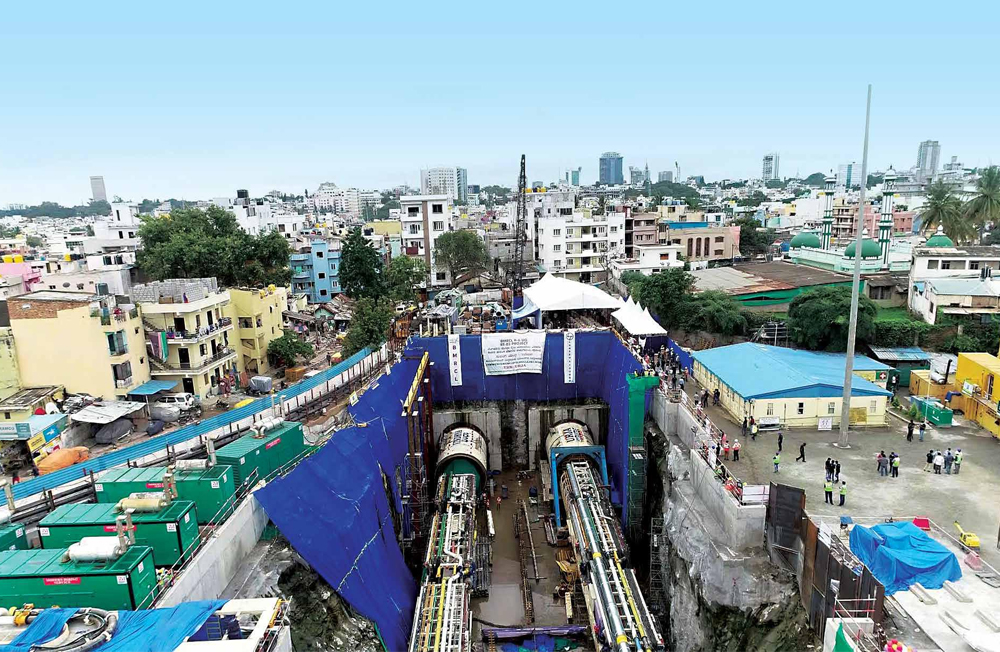
“We did it without outside help!”
Manufactured by the Chinese company, CRCHI, the assembly, commissioning, SATs and driving ‘Urja and ‘Vindhya’ for the first 500 m were to be supervised by the manufacturers. However, with travel restrictions due to COVID-19 and the growing anti-China sentiment fomenting in the country, the Chinese engineers could not make it. With pressure mounting from the client to start the critical tunnelling works, Sridharan and team took it upon themselves to get the TBMs rolling, albeit with some virtual guidance from the manufacturer. “Collectively, we had very little experience in TBM commissioning and zero experience in this type of Slurry TBMs,” remarks Sridharan, “but we took it on as a challenge and our young team of bright engineers were able to pull it off!”

Tunnelling work in progress at Bangalore Metro – RT 03

“Collectively, we had very little experience in TBM commissioning and zero experience in this type of Slurry TBMs, but we took it on as a challenge and our young team of bright engineers were able to pull it off!”
Sridharan Srinivasan
Project Manager, BMRCL RT-03
That is easier said than done for Sridharan and team had several brainstorming sessions with domain experts to understand the sequencing and risks involved at each stage, reached out to other project teams that had executed similar works about the challenges and pitfalls they had faced. Planning Manager, S Vignesh, who played a stellar role in the process adds, “we had microplanning sessions during the lockdown so that every team member was clear about his role.” Well prepared, the team got cracking the day the relaxations were announced and have not looked back since.

“We had microplanning sessions during the lockdown so that every team member was clear about his role.”
S Vignesh
Planning Manager, BMRCL RT-03
Handling a different kind of TBM
Although L&T has successfully executed tunnelling in the past using either EPB (Earth Pressure Balance) or Hard Rock TBMs, the Slurry TBMs being used to suit Bengaluru’s geological conditions were a new kettle of fish for Project Manager, Vivek Maruti Rai’s Pai at the RT 02 project. “Due to geological constraints, the excavation of the shaft was becoming too difficult,” shares Vivek, “forcing us to use an umbilical system to launch ‘Avni’ which is more complicated both in assembly and operation.” Vivek is, however, all praise for his team who rose to the occasion, that included one Chinese engineer. “We succeeded only due to our strong will power, appetite to learn new things and deep commitment helped by our experience in TBM launching and operations.”

“Cost of labour has gone up, lead time for material procurement has increased that is impacting progress, there has been a shortage of oxygen cylinders required for underground construction activities and of course, maintaining social distancing has been a pain.”
Vivek Maruti Pai
Project Manager, BMRCL RT-02
Some smart recruitment of TBM staff with the expertise in handling Slurry TBMs also helped. “We were in touch with the team from CRCHI digitally for clarifications regarding critical issues, successfully completed the SATs and commissioned ‘Avni’ on August 28th 2020,” exults an extremely pleased Planning Manager,
Vinayak Gaonkar, recalling the sleepless nights he had to endure. Their second TBM, ‘Lavi’ is being assembled and should get to work soon.
The goings and comings of migrant labour
Both Sridharan and Vivek will readily agree that Bengaluru’s treacherous underground conditions and overground traffic have been relatively easier to handle than the challenges posed by the pandemic.
Labour mobilization has been their toughest nut to crack. “Our TBM assembly had to be suspended because of rising positive cases,” shares Vivek with a shake of his head. “Cost of labour has gone up, lead time for material procurement has increased that is impacting progress, there has been a shortage of oxygen cylinders required for underground construction activities and of course, maintaining social distancing has been a pain.” His smile is equally painful.
With their domestic and international procurement plans hit for a six, Vignesh and his team immediately re-grouped. “We planned our material schedule in advance, expanded our vendor base by identifying multiple vendors from various cities and markets, created a dashboard with major markets in proximity to Bengaluru and monitored material dispatch status daily, ever ready to change if anything was looking risky.”
Over to the west, labour has been giving Project Manager, Yadavalli V N S Sarma a headache too at the
GMRC UG-2 project in Ahmedabad though after the relaxation of restrictions, the team commenced work on all available fronts and have completed major activities like tunnelling and base rafts for two stations.
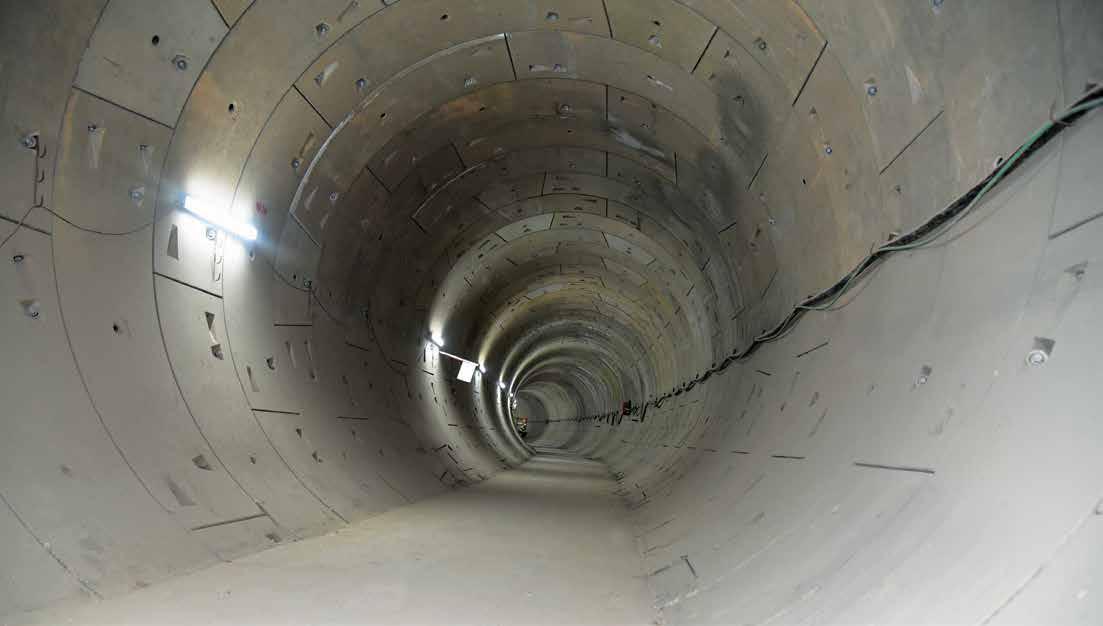
Section of tunnel at Ahmedabad Metro
“Though we started with only 80 workmen, by July, we had reached 70% of our strength and by August we have even surpassed pre-COVID numbers,” informs Planning Manager, Chandan Rai. Considering the priority of tunnelling works, the team flew in 100 workmen from Odisha while another 250 were mobilized from the states of Bihar, Jharkhand, West Bengal, and Uttar Pradesh.

Completion of TBM tunnelling at Ahmedabad Metro

All across sites, as part of SOP, new workmen are initially accommodated in separate buildings until certified ‘safe’, constantly educated about the precautionary measures to be taken, symptomatic cases immediately referred to company-hired Doctors or hospitals, number of vehicles increased for transportation, all premises regularly and thoroughly fumigated and sanitized. Sridharan, in fact, had to shift some 170 of his workmen to five other hostels, hotels and quarantine centres following protests from local residents.

“Though we started with only 80 workmen, by July, we had reached 70% of our strength and by August we have even surpassed pre-COVID numbers.”
Chandan Rai
Planning Manager, GMRC – UG-2
Focus on progress
At 10:57 am on August 13th 2020 Yadavalli’s team achieved a tunnel breakthrough of TBM S-71 between the Gheekanta and Shahpur stations. “With this, we completed the scope of west bound tunnelling covering 3.2 km from the launching shaft at Kalupur to Shahpur Station with a peak progress of 322 RMT per month,” shares an enthusiastic Sarma. A fortnight later on August 28th 2020, they achieved another breakthrough for TBM S-72, touching a peak progress of 40.8 RMT in a single day and 669.6 RMT by both the TBMs together for August, a sterling performance that even won the appreciation of the Hon’ble Chief Minister of Gujarat who congratulated the team with a personal tweet!
“This is also the first time that we have executed tunnelling off our own steam,” shares Yadavalli proudly. Works for both the Gheekanta and Shahpur underground stations have been completed till the base slab and the team is now carrying out cross passage construction and first stage concreting in the tunnel. “We are proceeding with activities like constructing the UPE wall, platform slab, columns, internal station structures, entry and exit points,” he updates. “Box pushing works are also going ahead full steam from the arrival shaft to Shahpur station.”


“We completed the scope of west bound tunnelling covering 3.2 km from the launching shaft at Kalupur to Shahpur Station with a peak progress of 322 RMT per month.”
Yadavalli V N S Sarma
Project Manager, GMRC – UG-2
“A major gain from the lockdown was that we were saved of the infamous traffic of Bengaluru,” quips Vivek, “being able to carry out road diversion works at all the three stations and successfully handed them over to the traffic police after restoration.” By completing the necessary decking required for subways, the team has made up precious time. Normally, subways are planned after completing the station box but by taking up this activity earlier, the team can complete both station and subway works together.

Reclamation works in Mumbai Coastal Road Project – Package 1
Significant headway above ground too
Both packages of the Mumbai Coastal Road project contend with working in the heart of South Mumbai and right in the heart of a red-hot COVID-19 zone. The project hardly had a lockdown, maintaining progress at the behest of the client, Municipal Corporation of Greater Mumbai, albeit with several restrictions. Project Manager, Rakesh Sisodia’s of Package 1 reels off some of his team’s key achievements. “On 21st May, we received 26,600 MT of material which was a record for a single day which we broke on 29th June, receiving 36,000 MT. During May, we achieved a reclamation footprint of 45,000 sqm and by the third week of July, we had mobilized 200 workmen.” Total workmen strength has since grown to 500 although labour mobilization and supply chain disruptions are perennial pain points for Rakesh and team.

“On 21st May, we received 26,600 MT of material which was a record for a single day which we broke on 29th June, receiving 36,000 MT. During May, we achieved a reclamation footprint of 45,000 sqm and by the third week of July, we had mobilized
200 workmen.”
Rakesh Sisodia
Project Manager, MCRP Package 1
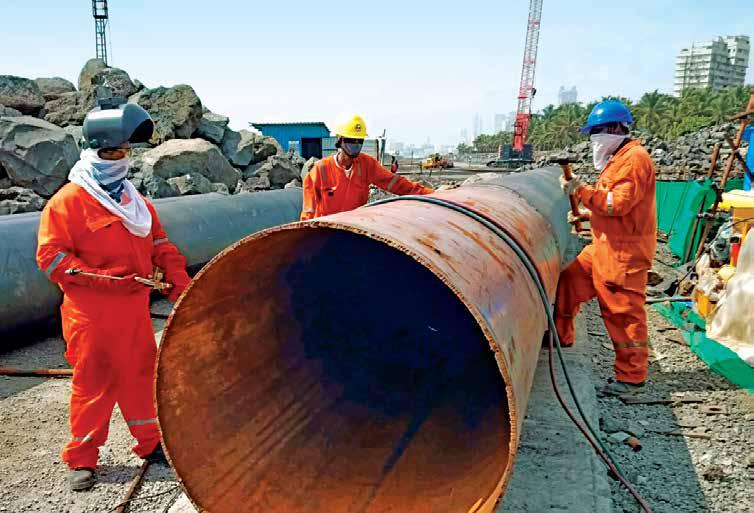
“Coming to terms with the pandemic gets harder with each passing day,” he sighs, “with the pressure of completing the sea wall and armour protection big challenges before the arrival of the monsoon.” The site has taken all necessary action such as premium rates for reported workmen for a particular affected duration and reassured subcontractors about their facilities both at sites and labour camps to combat COVID-19. “Everyone wanted to supply reclamation materials as it was easier to bring in tippers and dump on the seabed but what we wanted more urgently were armour stones of the required size and specified quality for the sea wall,” shares Planning Manager, K Jayesh. Trade of goods, supply of major construction materials and resource procurement are proceeding in high gear though, as Rakesh, points out, work on the interchange bridge took time due to issues in material supply and labour.
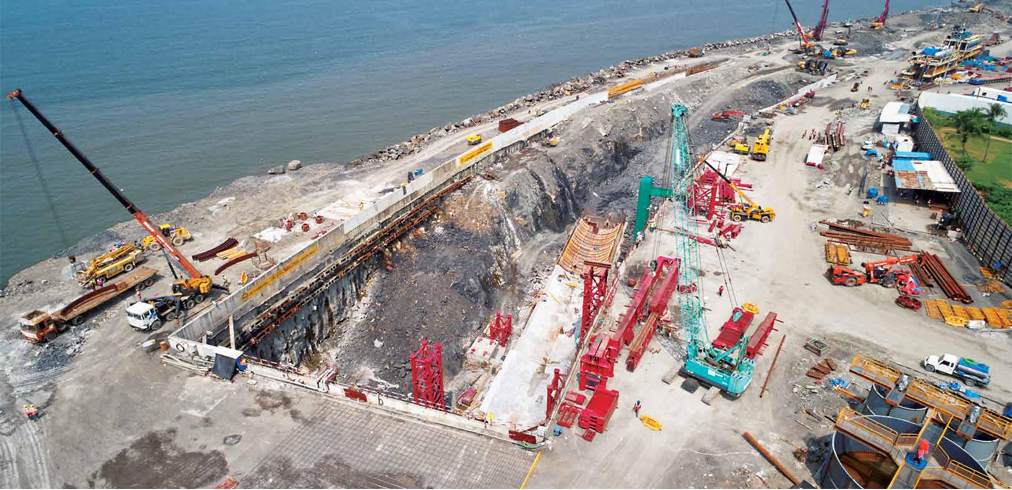
Aerial view of TBM Launching Shaft at MCRP Package – 4
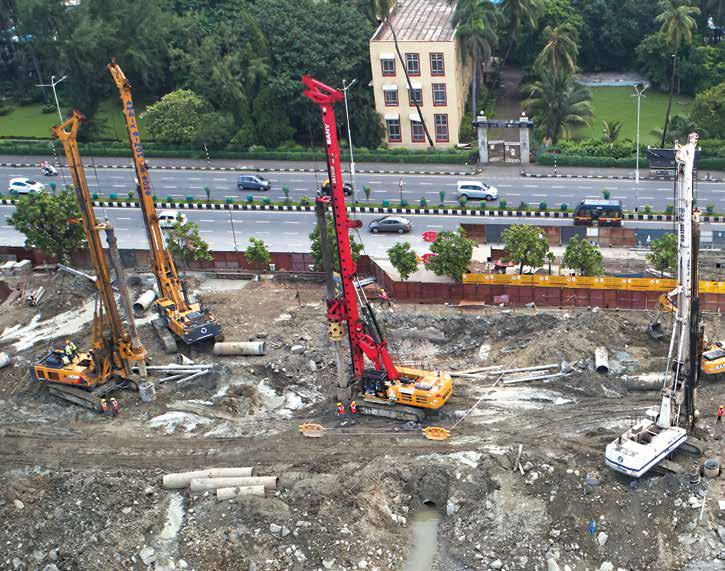
For Project Manager, Sandeep Singh at MCRP Package 4, one bothersome issue has been to appease the high society who reside in the vicinity of his site. They had issues with the number of workmen entering and leaving the site every day and hence the team had to strictly maintain social distancing. “They even filed petitions with the Bombay High Court for us working during the lockdown but thanks to the intervention of our client, we could continue,” recalls Sandeep. “We kept our focus and continued with the works on several fronts with a motivated workforce and full vendor support.”

“We have successfully completed 53% of the reclamation works as also the construction of the launching shaft for the tunnel drive. We have also started to assemble the TBM.”
Sandeep Singh
Proejct Manager, MCRP Package – 4
In every crisis lies an opportunity and Planning Manager, Utkarsh Bhakare was quick to seize it. “The material supply for seawall and reclamation material increased with dumpers able to complete multiple trips on the empty roads while the supply of concrete for the outfall works eased out as the RMC plants provided as per site requirement since they were operating on special permissions only for Coastal Road Works. Also, because of the absence of traffic, we could make traffic diversions on Marine Drive for Cut & Cover construction.” The TBM from China landed at the Mumbai Port during this period and with perfect coordination, it was brought to site in
6 days against the normal 15!
“We have successfully completed 53% of the reclamation works as also the construction of the launching shaft for the tunnel drive,” ticks off Sandeep. “We have also started to assemble the TBM.”
“The TBM from China landed at the Mumbai Port during the lockdown and with perfect coordination it was brought to site in 6 days against the normal 15! ”

Precast Segment Casting Yard at MCRP Package – 4
Even as the pandemic rages and the number of positive cases in the country keep rising alarmingly, our hardy foot soldiers across sites are manfully pressing on to make up for lost time and here is wishing them all the best and all the support the rest of the organization can provide.